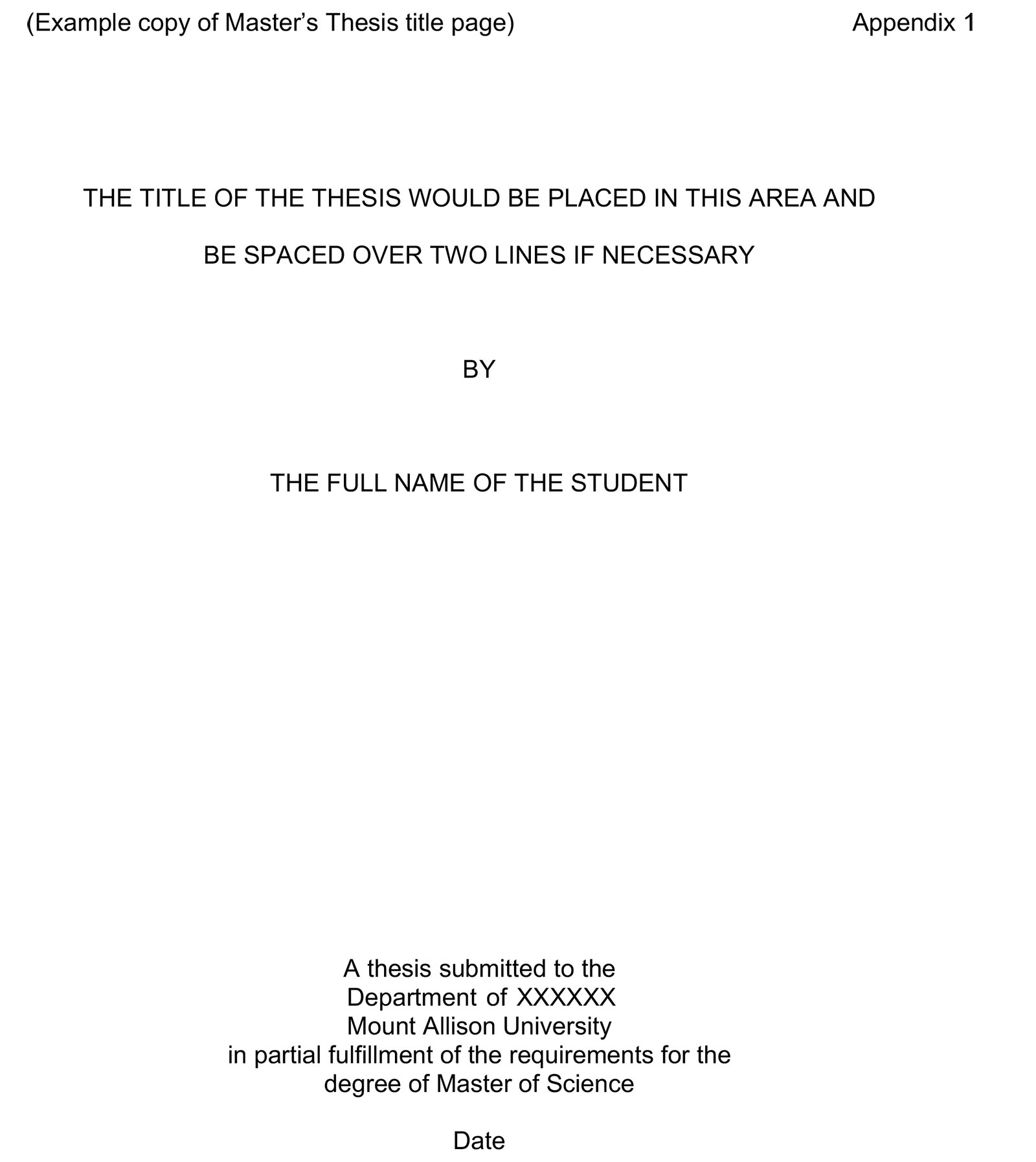Thesis formats
There are two acceptable thesis format options: traditional and paper.
The items to be included in either format are listed in detail below in the order they should appear in the thesis.
The choice of format used and the specific content of each section identified below should be made according to departmental requirements and in consultation with your supervisor and Thesis Supervisory Committee.
Instructions
Traditional thesis format
Beginning pages, including:
- Title page (example copy below)
- Examining committee completed signature page (Form GST2)
- Dedication (optional)
- Abstract
- Preface (optional)
- Acknowledgments (optional)
- Table of contents
- List of tables
- List of figures
- List of plates (if any)
- List of abbreviations or symbols (if any)
Body of text includes:
- Section 1) Introduction
- Section 2) Methods
- Section 3) Results
- Section 4) Discussion
- Section 5) Conclusion
- Section 6) Future directions (optional)
Closing pages, including:
- Bibliography
- Appendices (if any)
- Curriculum vitae (1 page maximum)
Paper thesis format
Papers that may be used for this thesis format include those prepared for submission, submitted, accepted, and published in peer-reviewed journals.
For multi-authored publications, a statement must be included indicating the candidate’s role in the publication.
Beginning pages, including:
- Title page (example copy below)
- Examining committee completed signature page (Form GST2)
- Dedication (optional)
- Abstract
- Preface (optional)
- Acknowledgments (optional)
- Table of contents
- List of tables
- List of figures
- List of plates (if any)
- List of abbreviations or symbols (if any)
Body of text includes:
- Section 1) Introductory chapter, to provide overview of entire thesis, complete with its own bibliography section.
- Section 2) Individual chapters presented as research papers, excluding abstract. Each chapter should be preceded by a statement of authorship.
- Section 3) Final chapter, general discussion and summation of thesis, complete with its own bibliography section.
- Section 4) Conclusion
- Section 5) Future directions (optional)
Closing pages, including:
- Appendices (if any)
- Curriculum vitae (1 page maximum)
Technical details
Library release form
Students are required to submit one copy of the Thesis Licence Agreement with their thesis. This form must be signed by the author in the appropriate place and must not be bound into the thesis.
Print quality and spacing
The print and duplication of the thesis must be of the highest quality. The thesis should be prepared using a word processor and printed from a laser printer. The type size should be 12 points with 1.5 or single line spacing, printed double sided on 8.5 by 11 inch (or 21.59 cm x 27.94 cm) paper.
Margins
A minimum left margin of 1.5 inches (or 3.81 cm) is required. The top, bottom, and right margins should be at least 1 inch (or 2.54 cm) on all pages of the thesis.
Page numbering
- Prefatory pages — All pages before the introduction will be numbered consecutively with Roman numerals beginning with the Abstract as page ii). The Title page will be page i) but will be left unnumbered. The Signature page will not be included in the numbering.
- Body of thesis — All pages of the thesis beginning with the Introduction chapter must be numbered consecutively with Arabic numbers (1, 2, 3 and so on). This includes all pages containing tables, figures, illustrations, the bibliography, appendices, and curriculum vitae.
Abstract
Abstracts should not exceed 250 words, and should provide a concise account of the work.
Footnotes and endnotes
For the traditional format thesis, notes may be placed at the foot of the page, in a group at the end of a chapter, or grouped at the end of the thesis before the Bibliography. If notes are collected at one place in the thesis, their location is to be shown in the Table of Contents by title and page.
For paper format theses, the notes are to be located within the appropriate chapter, either at the foot of the page, or grouped at the end of the chapter before the bibliography.
Bibliography or literature cited
Use a citation format which is appropriate to current usage for publication in your discipline.
Other items
Other pages including illustrative materials, tables, figures, photographs, maps, oversized pages, and the like, should be of consistent and high quality, both in the original and duplicated forms and the format should be appropriate for publication in your discipline.
Title page example

Questions? Email gradstudies@mta.ca

